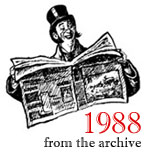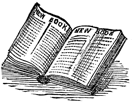
Teaching and Learning, Strutting and Conniving
HARVARD DIARY
These columns, which have been running for over six years, have been published under the common title of “Harvard Diary,” and yet the reader will no doubt have noticed by now that I haven’t been all that interested in writing much about the place where at least some of my work (the teaching I do) takes place.
Although I am a pediatrician and a child psychiatrist, and took psychoanalytic training as well, I don’t do much teaching in those fields, other than to supervise, occasionally, some hospital residents who are learning to work with children. Almost all my teaching time at Harvard is spent using novels and poems and short stories and occasional essays to explore moral or religious questions.
I teach two undergraduate courses, one titled “A Literature of Social Reflection,” the other “A Literature of Religious Reflection.” In the former we read writers such as Dickens, George Eliot, Hardy, Ralph Ellison, William Carlos Williams, Flannery O’Connor, and Walker Percy. The thrust of the course is toward the question of conduct: How ought I live this life? Novelists who take a close look at the world usually have an idea or two about its rights and wrongs, and their way of seeing things morally can be a helpful antidote to the rhetorical or the analytic approaches — the preaching of the clergy (not to mention various secular scolds) or the abstract pronouncements of philosophical theorists. Stories address and evoke concrete experience, and can inspire in the reader a mimetic, an empathic response: the psychological and moral imagination awakened. The class explicitly encourages discussion of a central issue in moral philosophy — how does one move from an intellectual analysis of ethical issues to a life that is honorable and decent? It also encourages students to be involved in volunteer activities — tutoring children, working with the sick, the elderly, the homeless — and we discuss in weekly sections their experiences in such activities, trying to connect the students’ reading to the actions.
You May Also Enjoy
Good fiction uses the events and tensions of everyday life on one level to draw us deeper and deeper into the writer’s perception of truth or reality on another.
At times Christian writers have entered that exclusive realm where profound insight into the wisdom of Christianity joins artistic merit to produce fiction of a higher order.
Holy Mother Church must generate tough guys, strong fathers specialized in spiritual warfare, to defend us in battle against the wiles and snares of the Devil.

